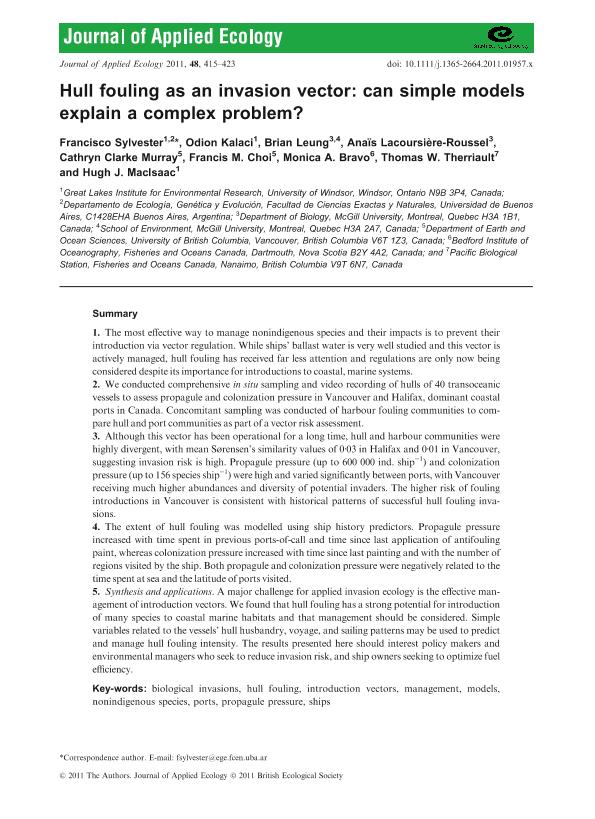Mostrar el registro sencillo del ítem
dc.contributor.author
Sylvester, Francisco

dc.contributor.author
Kalaci, Odion
dc.contributor.author
Leung, Brian
dc.contributor.author
Lacoursière Roussel, Anaïs
dc.contributor.author
Murray, Cathryn Clarke
dc.contributor.author
Choi, Francis M.
dc.contributor.author
Bravo, Monica A.
dc.contributor.author
Therriault, Thomas W.
dc.contributor.author
MacIsaac, Hugh J.

dc.date.available
2019-01-25T17:21:38Z
dc.date.issued
2011-04
dc.identifier.citation
Sylvester, Francisco; Kalaci, Odion; Leung, Brian; Lacoursière Roussel, Anaïs; Murray, Cathryn Clarke; et al.; Hull fouling as an invasion vector: Can simple models explain a complex problem?; Wiley Blackwell Publishing, Inc; Journal of Applied Ecology; 48; 2; 4-2011; 415-423
dc.identifier.issn
0021-8901
dc.identifier.uri
http://hdl.handle.net/11336/68622
dc.description.abstract
1. The most effective way to manage nonindigenous species and their impacts is to prevent their introduction via vector regulation. While ships' ballast water is very well studied and this vector is actively managed, hull fouling has received far less attention and regulations are only now being considered despite its importance for introductions to coastal, marine systems. 2. We conducted comprehensive in situ sampling and video recording of hulls of 40 transoceanic vessels to assess propagule and colonization pressure in Vancouver and Halifax, dominant coastal ports in Canada. Concomitant sampling was conducted of harbour fouling communities to compare hull and port communities as part of a vector risk assessment. 3. Although this vector has been operational for a long time, hull and harbour communities were highly divergent, with mean Sørensen's similarity values of 0·03 in Halifax and 0·01 in Vancouver, suggesting invasion risk is high. Propagule pressure (up to 600 000 ind. ship-1) and colonization pressure (up to 156 species ship-1) were high and varied significantly between ports, with Vancouver receiving much higher abundances and diversity of potential invaders. The higher risk of fouling introductions in Vancouver is consistent with historical patterns of successful hull fouling invasions. 4. The extent of hull fouling was modelled using ship history predictors. Propagule pressure increased with time spent in previous ports-of-call and time since last application of antifouling paint, whereas colonization pressure increased with time since last painting and with the number of regions visited by the ship. Both propagule and colonization pressure were negatively related to the time spent at sea and the latitude of ports visited. 5. Synthesis and applications. A major challenge for applied invasion ecology is the effective management of introduction vectors. We found that hull fouling has a strong potential for introduction of many species to coastal marine habitats and that management should be considered. Simple variables related to the vessels' hull husbandry, voyage, and sailing patterns may be used to predict and manage hull fouling intensity. The results presented here should interest policy makers and environmental managers who seek to reduce invasion risk, and ship owners seeking to optimize fuel efficiency.
dc.format
application/pdf
dc.language.iso
eng
dc.publisher
Wiley Blackwell Publishing, Inc

dc.rights
info:eu-repo/semantics/openAccess
dc.rights.uri
https://creativecommons.org/licenses/by-nc-sa/2.5/ar/
dc.subject
Biological Invasions
dc.subject
Hull Fouling
dc.subject
Introduction Vectors
dc.subject
Management
dc.subject
Models
dc.subject
Nonindigenous Species
dc.subject
Ports
dc.subject
Propagule Pressure
dc.subject
Ships
dc.subject.classification
Otras Ciencias Biológicas

dc.subject.classification
Ciencias Biológicas

dc.subject.classification
CIENCIAS NATURALES Y EXACTAS

dc.title
Hull fouling as an invasion vector: Can simple models explain a complex problem?
dc.type
info:eu-repo/semantics/article
dc.type
info:ar-repo/semantics/artículo
dc.type
info:eu-repo/semantics/publishedVersion
dc.date.updated
2019-01-25T13:35:45Z
dc.journal.volume
48
dc.journal.number
2
dc.journal.pagination
415-423
dc.journal.pais
Reino Unido

dc.journal.ciudad
Londres
dc.description.fil
Fil: Sylvester, Francisco. University of Windsor. Great Lakes Institute for Enviromental Research; Canadá. Universidad de Buenos Aires. Facultad de Ciencias Exactas y Naturales. Departamento de Ecología, Genética y Evolución; Argentina. Consejo Nacional de Investigaciones Científicas y Técnicas; Argentina
dc.description.fil
Fil: Kalaci, Odion. University of Windsor. Great Lakes Institute for Enviromental Research; Canadá
dc.description.fil
Fil: Leung, Brian. McGill University; Canadá
dc.description.fil
Fil: Lacoursière Roussel, Anaïs. McGill University; Canadá
dc.description.fil
Fil: Murray, Cathryn Clarke. University of British Columbia; Canadá
dc.description.fil
Fil: Choi, Francis M.. University of British Columbia; Canadá
dc.description.fil
Fil: Bravo, Monica A.. Fisheries and Oceans Canada; Canadá
dc.description.fil
Fil: Therriault, Thomas W.. Fisheries and Oceans Canada; Canadá
dc.description.fil
Fil: MacIsaac, Hugh J.. University of Windsor. Great Lakes Institute for Enviromental Research; Canadá
dc.journal.title
Journal of Applied Ecology

dc.relation.alternativeid
info:eu-repo/semantics/altIdentifier/doi/http://dx.doi.org/10.1111/j.1365-2664.2011.01957.x
dc.relation.alternativeid
info:eu-repo/semantics/altIdentifier/url/https://besjournals.onlinelibrary.wiley.com/doi/full/10.1111/j.1365-2664.2011.01957.x
Archivos asociados
